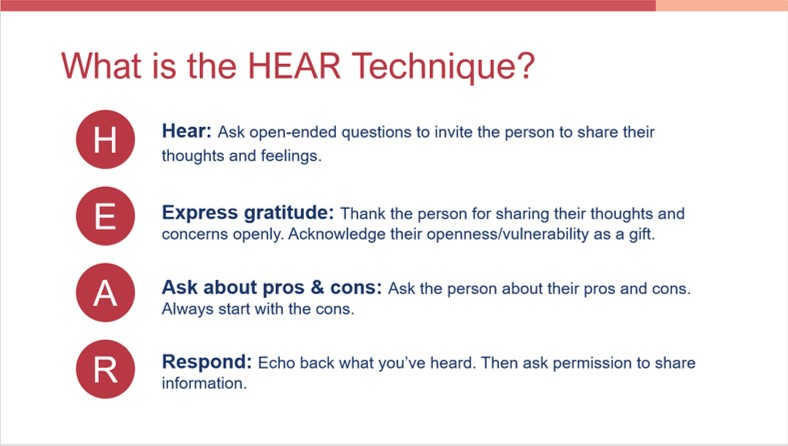
Vaccination is an essential public health intervention to prevent disease, especially among vulnerable populations; increased vaccine hesitancy threatens vaccine uptake. Healthcare staff, while recognized as trusted messengers by many people, report reluctance to engage with patients who express vaccine hesitancy. The UCSF Center for Excellence in Primary Care (CEPC) developed the HEAR technique, a brief intervention tool to engage with people who are unsure or hesitant about vaccines.
To date, CEPC has trained clinical staff, community health workers, disease intervention specialists, and vaccine outreach workers on the HEAR Technique.
Interested in training for your organization? Contact: Patricia Mejia.
Learn more
- Download this Guide to use the HEAR Technique.
- Mejía P, Faustino LSD, DiGiammarino A, Sigerman T, Sanchez S, Dunn C, Tougas J, Kryger V, Maher A, Willard-Grace R. Trauma-informed health coaching: A practical guide for COVID-19 and other disease intervention interviews. Public Health Chall. 2023; 2:e144.
- Read a blogpost in KevinMD by former CEPC Health Coach and Trainer Alicia DiGiammarino, "Try this Technique when talking to vaccine skeptics." Blogpost. KevinMD. 7 August 2021.
- Learn more about how Health Coaching Tools can be used in Contact Tracing and Case Investigation
- Harris OO, Taylor KD, Maher A, Willard-Grace R. Health Coaching Across the Stages of Vaccine Readiness and Action: A Practical Guide for Public Health Nurses. Am J Public Health. 2022 Jun;112(S3):S245-S249. doi: 10.2105/AJPH.2022.306774. PMID: 35679570; PMCID: PMC9184909.
